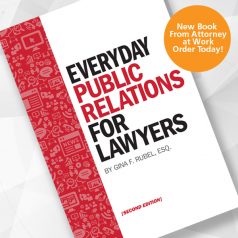In today’s research-driven marketplace, studies show that prospective clients complete between 70% to 90% of the decision-making process online before engaging by email or phone. Accordingly, your digital presence — especially your professional bio — must quickly establish your authority and accessibility as a source of legal counsel.
How can your website bio exert maximum impact on a prospect’s initial evaluation? Once prospects arrive at your biography, they are looking to validate their decision. If your bio does not speak to the buyer’s need or problem, reading what you deem to be most important or impressive about yourself is not likely to be persuasive.
Your professional bio is the place where prospects can determine whether they like and trust you enough to solve a certain legal issue and whether it is worth picking up the phone. The average buyer spends 15 seconds on a bio webpage, which means you have only 15 seconds to grab their attention and validate their decision to choose you.
Here are three tactics to create an engaging web bio that will drive business, speak directly to your potential client and put your best foot forward.
1. Know Your Audience: Focus on Benefits to Clients Instead of Features
An effective bio highlights the benefits of working with you and describes how your legal services help clients solve or avoid problems.
Benefits show your audience what they will gain by working with you or your law firm — in other words, why your services matter. Take the next step and provide an example or two of how your work on employment issues made a difference for an engineering firm or a chain of 11 stores.
Sadly, most lawyer biographies do not focus on the buyer in this manner. Instead, they communicate features about the lawyer: the areas of law within which they practice; their education and professional background; courts to which they are admitted to practice; articles or treatises they have published; and the all-important number of years they have been in practice.
Such features do establish credibility and distinguish your experience from that of your competitors. They also look past the buyer instead of addressing the prospective client’s concerns. Beware of following this path.
Moreover, ensure the content reflects your most recent work and accolades. If the most significant matter you highlight happened five years ago, prospective clients will wonder what you have done in the interim.
According to Melissa Marshall, director of marketing for employment law firm Laner Muchin, prospects want to know more about a lawyer than where they went to school and basic information about their practice.
“Clients and potential clients know that the lawyers went to great law schools and are fantastic at what they do,” she says. “By demonstrating sound thought leadership and presenting their know-how, however, there is greater validation which produces results.”
Additionally, your firm’s strategic business development and communications plan can help identify appropriate content relating to your strengths. The best way to position a lawyer as a thought leader through “public relations and how it supports marketing efforts is to have the attorneys speak publicly, write articles, and participate on panels,” Marshall says. “It is all great content to repurpose on social media and in attorney biographies.”
2. A Picture Is Worth a Thousand Words … But Only If It’s Current
The human brain processes visual information 60,000 times faster than it processes text, making images critical. Your portrait sets the tone for prospective clients, even before they read a word. Digitally savvy prospects will quickly discern a low-resolution photo apparently was taken a decade (or more!) ago.
This is why you must invest in the services of a professional photographer. Headshots have a shelf life of four to eight years (depending on how often you change your hairstyle or perhaps facial hair). If your headshot is more than eight years old, it is past time for a new photo. During that first Zoom session, you want the client to recognize your face as being very like your appearance online. Don’t let a prospective client wonder, “Is this the same lawyer whose bio I saw?” Buyers will overlook gray hairs or a few extra pounds, but they are wary of any deception, no matter how benign an outdated photo may seem.
The photographer will advise you on the appropriate pose and angle, and whether to use a closely cropped headshot or a more natural shot. Clients will interpret your facial expression (smiling or straight-faced), arm position (crossed arms or an open posture) and head angle (tilted or not) based on their personal experiences and societal norms. Let your eyes do the talking: Your photo should match the professional persona you wish to project.
3. The 411 on SEO
Search engine optimized content will increase your chances that prospective buyers will find you online. If you haven’t yet done so, determine relevant keywords and phrases you want to rank for and use them in your web bio and other online content. Review the text with tools like SEMRush or Trendkite to compare your score to your competitors’ performance.
- Use specific keyword phrases and terms in your content. This will boost the likelihood that such words will drive web traffic and influence search engine ranking, thereby sending more potential clients to your page. Descriptive language based on how your audience searches for your services has an impact as well. For example, compare “Jane is a trademark lawyer in Chicago” with “Jane is a lawyer.”
- Ensure your bio is easily digestible instead of a wall of text. This applies even if Google algorithms indicate that longer-form content (more than 1,000 words) performs better for SEO than shorter text. Expanded subheadings are your friend — they make it easier for readers to find the information they seek. Consider human readability, while still catering to the bots and web crawlers. Paragraph length is among the most important signals you send to readers, delivering your bio as easy and interesting to read. When paragraphs are too dense, the content seems cumbersome and uninviting. When they are all the same length, the information may appear boring. Vary your paragraph lengths to create a sound rhythm. Shorter is better. Ideally, paragraphs are three sentences or less, and occasionally, a single-sentence paragraph is acceptable.
- Perhaps most important, update your bio frequently to keep those bots busy. Even minor tweaks can create fresh content, which will perform better in search engine indexes.
By focusing on the benefits to the potential client, revising your bio for SEO and updating your photo, your new digital portrait will speak powerfully to the reader. Then it will confirm that you are the answer to their search for legal advice.
For More Tips on Improving Your Image …
 “Everyday Public Relations for Lawyers”
“Everyday Public Relations for Lawyers”
In the new second edition of “Everyday Public Relations for Lawyers,” public relations and communications specialist Gina Rubel covers everything you need to know about modern public relations — including the key items to include in your firm’s strategic communications plan. Get ahead this year by following Gina’s clear, no-nonsense advice, checklists and templates for promoting yourself, your firm and your clients.
Published by Attorney at Work and available in our bookstore, here.























